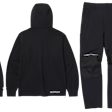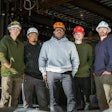
As with any personal protective equipment (PPE) on the worksite, it is important to consult with a safety manager to ensure head protection meets required safety standards while enabling a worker to have what is needed to complete the necessary job tasks.
Head protection that meets the ANSI/ISEA Z89.1 standard also complies with Occupational Safety and Health Administration (OSHA) regulations.
Climbing Helmets
Some workers may consider work from height climbing helmets, which are designed to protect a worker’s head from falling objects and impacts while working at height. They are designed to provide a stronger shell that provides full coverage around the sides and back of the head for more protection.
Impact absorption is made possible through a different liner material or more padding as to absorb more effectively the impact of a fall or a falling object.
A four-point chin strap is designed to keep the helmet securely on a worker’s head in case of a fall. The helmets typically have ventilation holes to allow air to circulate and keep the head cool and comfortable. A suspension system moves impact force through the body to the feet to reduce head, neck, and spine strain.
Some helmets may feature a sweatband and slots for headlamps, earmuffs and visors.
The company HexArmor notes that while climbing-style safety helmets are governed by European standards, there is currently no U.S. standard that addresses them. A climbing style helmet that indicates it is ANSI or OSHA approved is likely an ANSI Type 1 safety helmet with climbing-style features.
When looking at ratings on head PPE, consider the type and class.
Construction Hard Hat Classifications
A hard hat type indicates the level of protection, while class indicates the degree of electrical performance. Type 1 head protection offers protection from blows to the top of the head, while Type II offers protection from blows to the top and sides of the head.
- Class E helmets are for use where electrical hazards are present (in utility services) that are non-conducting and intended to protect against falling objects and reduce the danger of exposure to high voltage electrical shocks and burns. They offer the highest protection with high-voltage shock and burn protection up to 20,000 volts.
- Class G is general (limited voltage - non-conducting) use intended to protect against falling objects and reduce the danger of exposure to low voltage electrical conductors. They provide impact and penetration resistance and protection from up to 2,200 volts.
- Class C hard hats are designed for lightweight comfort and impact protection but are not tested for electrical resistance nor do they provide protection from electrical conductors.
Other important factors in making any head PPE choice include temperature fluctuations in which the work is being conducted and high visibility.
Changes in Head Protection
OSHA has acknowledged that head protection has changed over time and in mid-December, the agency announced it is replacing traditional hard hats used by its own employees with more modern safety helmets to protect them better when they are on inspection sites.
The U.S. Bureau of Labor Statistics in 2020 reported head injuries accounted for nearly six percent of non-fatal occupational injuries involving days away from work. Almost half of those injuries occurred when workers encountered an object or equipment while about 20 percent were caused by slips, trips, and falls. Since the 1960s, traditional hard hats have protected the top of a worker's head but have minimal side impact protection and lack chin straps.
OSHA acknowledges it wants employers to make safety and health a core value in workplaces and is committed to doing the same by leading by example and embracing the evolution of head protection.
The agency acknowledges without the straps, traditional hard hats can fall off a worker's head if they slip or trip, leaving them unprotected. Additionally, they have lacked vents and trapped heat inside. In late 2023, OSHA published a safety and health information bulletin detailing key differences between traditional hard hats and more modern safety helmets and the advancements in design, materials and other features helping to better protect workers’ heads.
Today's safety helmets may also offer face shields or goggles to protect against projectiles, dust and chemical splashes, built-in hearing protection, and communication systems to enable clear communication in noisy environments.
















